
Side view of the Richards stoneware kiln on the Delaware River waterfront in Lamberton, New Jersey. Scales are in feet and inches. (Courtesy, Hunter Research, Inc., Trenton, New Jersey.)
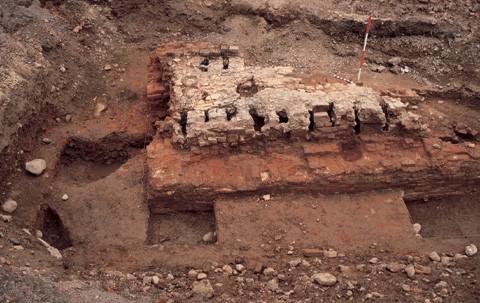
Side view of the Richards stoneware kiln showing vents in the chamber floor. Scales are in feet and inches.

End view of the Richards kiln displaying an opening for one of the two fireboxes in foreground with the floor of the kiln chamber beyond. Scales are in feet and inches.

Pipkin recovered from the Richards kiln. Salt-glazed stoneware. Scale is in inches and centimeters.
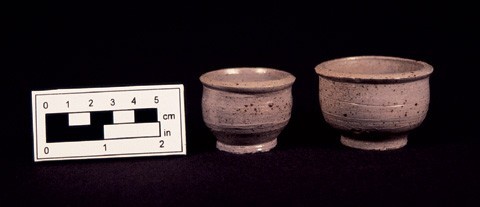
Two small sampler vessels or condiment pots from the Richards site. Salt-glazed stoneware. Scale is in inches and centimeters.
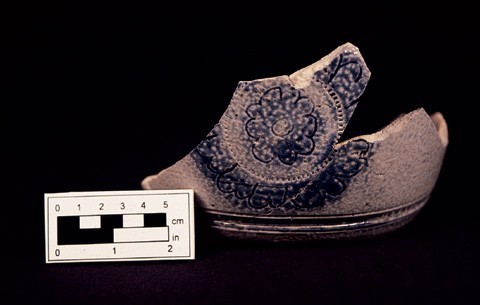
Chamberpot. Salt-glazed stoneware. Example of typical Richards multi-lobed floral design highlighted in cobalt. Scale is in inches and centimeters.
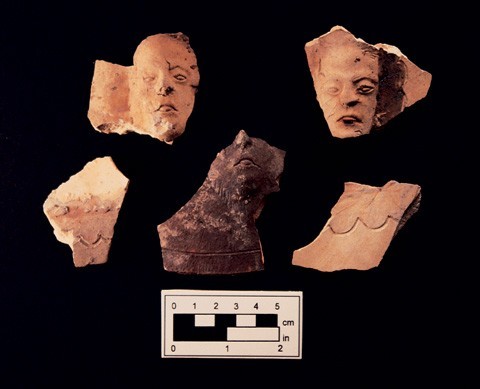
Examples of applied molded Bellarmine-like faces on sherds found during excavations. Scale is in inches and centimeters.
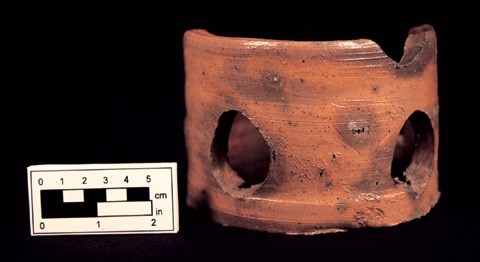
Cylindrical sagger with cut holes, excavated at the Richards stoneware kiln. Scale is in inches and centimeters.
In May 2000 an eighteenth-century stoneware kiln was discovered on the banks of the Delaware River in Lamberton, New Jersey, the port community of the state’s capital, Trenton. This rare find occurred during the reconstruction of New Jersey’s Route 29 along the riverbank. Earthmoving machinery grading the road bed exposed a large void that turned out to be the remains of a brick firebox at one end of a kiln (fig. 1). Under archaeological monitoring conditions, specified by a memorandum of agreement and written into the contractor’s work specifications, the New Jersey Department of Transportation made provision for a ten-day emergency excavation by the project’s archaeological consultant, Hunter Research, Inc. This action enabled the kiln to be exposed and recorded, and a sample of wares and kiln furniture to be recovered.
Documentary references make mention of a stoneware pottery operating in Lamberton in the 1770s, but the precise location of this facility remained unclear until this find. The pottery is securely linked to William Richards, a Philadelphia merchant with fishing and commercial interests in the Delaware Valley, who was leasing property in Lamberton by 1765. In 1774, a newspaper advertisement placed by Richards notes his having erected a manufactory at Lamberton, about a half mile below Trenton, for making the useful Dutch stoneware and sand crucibles.[1] He also had acquired a new boat to service his Lamberton commercial interests, presumably to bring in raw materials and ship out finished products. In 1778, Richards advertised for a potter who knew how to make stoneware, indicating that he was hiring craftsmen to produce his line. The pottery probably ceased operation around the time of Richards’s death in 1787.
The kiln was located less than fifty feet or so from the shoreline, within a complex of other late-eighteenth-century buildings, most of which appear to have been warehouses and workshops used by Richards and others involved in shipping goods on the river. The kiln was a rectangular structure measuring 14.5 feet by 8.5 feet with a firebox protruding out an additional three feet from each end. Much of the structure stood to a height of around four feet and most of the kiln’s upper chamber floor (8.5 feet by 3 feet in plan) survived intact (fig. 2). The kiln, an updraft type, most likely had an upper chamber with an arched roof. The better preserved of the two domed fireboxes, 1.8 feet wide by 4.2 feet high, was still connected to the kiln’s flue system, which essentially consisted of a single ring-like, vented conduit circling beneath the chamber floor (fig. 3). This firebox sat over an ash- and lime-filled, brick-lined trough straddled by iron pigs that served both as a grate for wood fuel and as integral supporting elements within the overall kiln structure. The two troughs at either end of the kiln fed into an ash pit.
A mass of wasters and kiln furniture was gathered from the soils around the kiln, sufficient to characterize the site’s production and the mode of stacking wares in the kiln chamber. The Richards’s pottery manufactured a variety of salt-glazed, gray fabric vessels including milk pans, plates, bottles, jugs, tankards, porringers, bowls, crocks, pipkins (fig. 4), condiment pots (fig. 5), and chamber pots. As well, the pottery produced more unusual items, like inkwells, candlestick holders, and a press-molded teapot with lion paw feet. Several different base and handle styles are evident, but the most distinctive feature of the Richards’s output was the use of certain decorative treatments: incised multi-lobed flowers (fig. 6), fishscale triangles, and checkerboards; molded or sprigged designs of floral reliefs and Bellarmine-like faces (fig. 7); rouletted “penny” medallions; and fleurs-de-lis and watch spring motifs painted in cobalt blue. One intriguing sherd was found bearing the impressed typeset initials “WR,” presumably reflecting the pottery’s ownership. Both formal and makeshift kiln furniture items were recovered. Props, shelves, and large cylindrical saggars with cut holes (fig. 8) fall within the former category; wads, pads, pillows, crescents, and abundant brick fragments represent the bulk of the latter.
The identification of the Richards’s pottery is of great historical and archaeological interest, not just in the regional context of stoneware production in the middle colonies, but also because Richards had business interests in the Caribbean and we may expect these wares to be found far afield in the New World. The site is one of only three archaeologically documented eighteenth-century stoneware kilns on the eastern seaboard (the other two are in Yorktown, Virginia,[2] and Cheesequake, New Jersey). It was deemed impractical to remove the kiln physically from the riverbank; doing so would likely result in structural damage and create a major long-term conservation issue. More important, removal of the kiln would sever it from its archaeological context when it is clear that substantial unexamined remains will still exist along the riverbank even after the highway’s construction. On this basis, the kiln has been left in place—packed in sand, marked on the highway as-built drawings—and now lies sealed beneath the roadway, awaiting reexamination several decades hence.
Richard Hunter, Ph.D.
President and Principal Archaeologist
Hunter Research, Inc.
<rwhunter@hunterresearch.com>
<http://www.hunterresearch.com>
Reprinted in New York Gazette and the Weekly Mercury, August 22, 1774. Reprinted in Newspaper Extracts, vol. 10, 1773–1774, New Jersey Archives First Series, edited by William Nelson, vol. 29 (Paterson, N.J.: Call Printing and Publishing, 1917).
Norman F. Barka, “The Kiln and Ceramics of the ‘Poor Potter’ of Yorktown: A Preliminary Report,” in Ceramics in America, edited by Ian M. G. Quimby. Winterthur Conference Report (Winterthur, Del.: Winterthur Museum, 1972), pp. 291–318.
